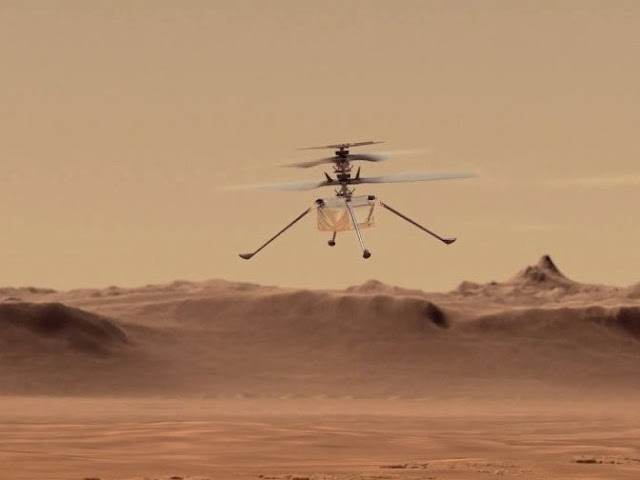he helicopter will rise for about six seconds, hover and rotate for about 30 seconds, then go back down. The flight will be autonomous, pre-programmed into the aircraft because of the 15 minutes it takes for signals to travel from Earth to Mars. Ingenuity itself will analyze its position with respect to the Martian surface.
After the flight, Ingenuity will send Perseverance technical data on what it has done, and that information will be transmitted back to Earth. This will include a black and white photo of the Martian surface that Ingenuity is programmed to snap while flying. Later, once its batteries have charged up again, Ingenuity is to transmit another photo -- in color, of the Martian horizon, taken with a different camera.
But the most spectacular images are supposed to come from the rover Perseverance, which will film the flight from a few meters away. Shortly after this filming, six videos of 2.5 seconds each will be sent to Earth. NASA hopes at least one of them will show the helicopter in flight.
The entire video will be sent over the following few days. "There will be surprises, and you will be learning about them right at the same time that we will. So let's all get the popcorn," said Elsa Jensen, who oversees the cameras on the rover.
The helicopter hovered for 30 seconds at its intended altitude of 10 feet (3 meters), and spent 39 seconds airborne, more than three times longer than the first successful flight of the Wright Flyer, which lasted a mere 12 seconds on Dec. 17, 1903. To accomplish all this, the helicopter’s twin, counter-rotating rotor blades needed to spin at 2,500 revolutions per minute — five times faster than on Earth. With an atmosphere just 1% the density of Earth’s, engineers had to build a helicopter light enough — with blades spinning fast enough — to generate this otherworldly lift. The Martian wind was relatively gentle Monday: between 4 mph and 14 mph (7 kph to 22 kph). More than six years in the making, Ingenuity is just 19 inches (49 centimeters) tall, a spindly four-legged chopper. Its fuselage, containing all the batteries, heaters and sensors, is the size of a tissue box. The carbon-fiber, foam-filled rotors are the biggest pieces: Each pair stretches 4 feet (1.2 meters) tip to tip.
Ingenuity also had to be sturdy enough to withstand the Martian wind, and is topped with a solar panel for recharging the batteries, crucial for surviving the minus-130 degree Fahrenheit (minus-90 degree-Celsius) Martian nights.NASA chose a flat, relatively rock-free patch for Ingenuity’s airfield. Following Monday’s success, NASA named the area for the Wright brothers.


Comments
Post a Comment
If you have any doubt let me know in the comment section where i can try to solve it .
Thank you